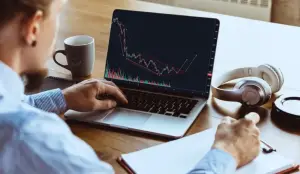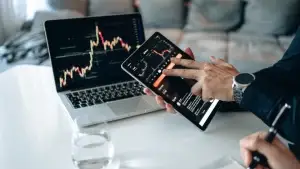Learning to trade is an investment in yourself that will pay off throughout your life. In a rapidly changing financial world, understanding the basics of stock trading and the corresponding strategies is crucial to achieving financial independence. This approach opens up access to the world of investments, provides the opportunity to manage your assets, and increases confidence in your decision-making.
The Benefits of Learning to Trade: An Investment That More Than Pays for Itself
Trading training in Russia involves studying the legal regulations governing the stock market. According to Federal Law No. 39-FZ “On the Securities Market,” traders must meet certain requirements, including tax reporting. For example, the tax on trading income for residents of the Russian Federation is 13%. The knowledge taught in the courses includes, among other things, practical tips on tax optimization and competent risk management. Without understanding these aspects, it is impossible to achieve complete financial independence.

Trading training provides financial literacy. During training sessions, experts explain the basics of investing, technical analysis, and market trends so that listeners can develop a deeper understanding of how the stock market works and consciously choose the best investment methods.
Consistent Income Growth and the Possibility of Passive Income
 Investing in the stocks of large Russian companies such as Gazprom, Sberbank, and Lukoil can form the basis for creating a stable passive income. For example, the average dividend yield on Sberbank shares in 2023 was around 7%. This is significantly higher than the yield on most bank deposits. Traders can also invest in ETFs traded on the Moscow Stock Exchange to diversify their portfolio and reduce risk. By using long-term strategies, such as the averaging method, they can maintain returns of 10–15% per year and minimize the impact of market fluctuations.
Investing in the stocks of large Russian companies such as Gazprom, Sberbank, and Lukoil can form the basis for creating a stable passive income. For example, the average dividend yield on Sberbank shares in 2023 was around 7%. This is significantly higher than the yield on most bank deposits. Traders can also invest in ETFs traded on the Moscow Stock Exchange to diversify their portfolio and reduce risk. By using long-term strategies, such as the averaging method, they can maintain returns of 10–15% per year and minimize the impact of market fluctuations.
Flexibility in Professional Training: The Opportunity to Learn Anytime, Anywhere
Today, there are many educational platforms on the domestic market, such as Skillbox, GeekBrains, and FINAM, that offer online trading training. Courses include access to teaching materials, exams, and real-life cases from the practice of Russian and international traders. The cost of the programs can range from 10,000 to 50,000 rubles, depending on the complexity and duration.
One of the advantages of the online format is the ability to determine your own learning pace. This is especially important for those who don’t just want to “go over the material” but truly want to thoroughly understand and master all the intricacies of stock trading.
Advantages:
- Individual scheduling: The ability to adapt the process to your work and personal schedule.
- It doesn’t matter where you are: all you need is internet access, and you can learn on the go.
- Professional support: Regular masterclasses and webinars from leading traders offer the opportunity to ask questions and receive feedback.
- Practical Application: By participating in trading simulations, you can immediately consolidate the knowledge you’ve acquired in practice.
How Learning to Trade Changes Your Perspective on Investing
Many people are afraid of investing because they don’t understand how the market works. Learning to trade from scratch helps overcome this barrier. During courses and practical exercises, you’ll acquire knowledge that will allow you to make informed decisions instead of relying on luck or intuition. This will eliminate the fear of investing and give you control over your finances.
Trading for Beginners: The First Step to Freedom
The best way to start your journey to financial freedom is with the basics. Learn the basics of the market, how stock markets work, and what factors influence price movements. After thorough training, anyone can participate in trading, apply the knowledge gained to market analysis, and find profitable trades.
It’s important to understand that trading is a systematic and conscious process that requires knowledge and patience. For this reason, high-quality education is key to successful investments and helps minimize risks.
What does high-quality trading training include?
Technical analysis relies on tools such as moving averages, support and resistance levels, and MACD and RSI indicators. For example, using a 200-day moving average can help identify long-term trends and market entry points. It’s also important to consider trading volumes: they provide insight into the strength of the current trend. As part of the courses, trading training includes learning software such as MetaTrader 5, which enables technical analysis and the standardization of historical data to make more informed decisions.
The main objective of analysis is to enable a trader to know when to buy and sell assets. Without this tool, trading becomes a game of chance with no room for conscious decision-making.
Trading Strategies: The Path to Success
Each tactic has its own characteristics:

- Scalping, for example, involves many short trades throughout the day, requiring high levels of concentration and quick reactions. On average, scalpers in the Russian market close between 10 and 50 contracts per day, trying to profit from even the smallest price changes.
- Trend trading is a strategy that takes advantage of long-term trends, such as the growth of Yandex stock in recent years. During trading training, novice traders learn to identify trends using indicators and analyze the impact of news on an asset’s price, which contributes to developing a sustainable trading approach.
Practical Training: Training Courses and Masterclasses
We’re talking about simulated trading and real-life work with demo accounts. The FINAM platform offers the opportunity to open a demo account and try your luck in real market conditions without risking your money. This allows beginners to understand how the stock market works and gain initial experience, which is necessary for a successful start. Furthermore, masterclasses from leading traders like Alexander Gerchik provide a unique opportunity to gain knowledge directly from professionals who have already gone through all the stages and are ready to share their experience.
Conclusion
 Learning to trade is not just a way to make money in the stock market. It’s an investment in yourself, in your future, in your freedom. The knowledge and skills acquired through the study of this subject will open the doors to financial independence, giving you the ability to control your income and make decisions that affect your quality of life.
Learning to trade is not just a way to make money in the stock market. It’s an investment in yourself, in your future, in your freedom. The knowledge and skills acquired through the study of this subject will open the doors to financial independence, giving you the ability to control your income and make decisions that affect your quality of life.
 en
en  ru
ru  de
de  ar
ar  es
es  hi
hi  fr
fr  nl
nl  it
it  pt
pt  el
el 










